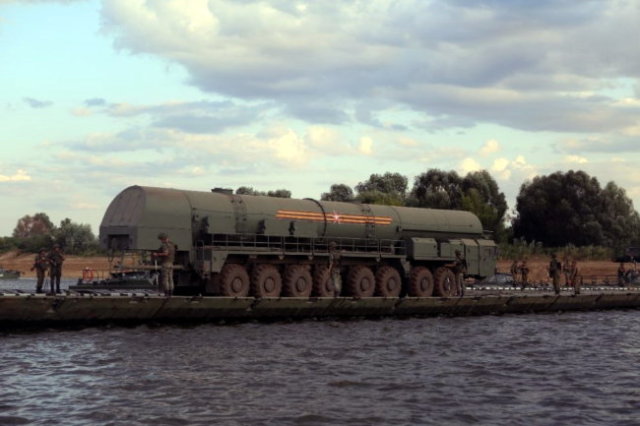On Wednesday, July 28, at a special exercise in the Vladimir region, the engineering troops conducted a unique operation, the place of which is in the Guinness Book of Records.
For the first time in world practice, pontoon units equipped a double-width floating bridge. This crossing with a lifting capacity of 120 tons ensured the transfer of a large number of people and large-sized equipment across the Oka. Moreover, the traffic intensity on the temporary bridge was twice as high as the standard one.
The fact is that the unique pontoon crossing made it possible to let the streams of military vehicles simultaneously in passing directions and not stop the movement when the river is agitated up to 3 points.
According to the plan of the operation, enemy saboteurs destroyed road and railway bridges near the field positions of the missile division. There were no duplicate crossings providing passage of heavy large-sized equipment in these areas. In short, a difficult situation was created, which required the use of pontoon units.
The peculiarity of this exercise was also that it was necessary to throw a battery of the Yars mobile ground missile system of the Teikovsky division of the Strategic Missile Forces across the Oka over the bridge. Four years ago, in the Ivanovo region, a column of large-sized equipment, which included a 100-ton eight-axis autonomous launcher "Yarsa", was successfully transported across the Nerl River.
But it was a single launcher, and the width of the forced sections did not exceed 50 meters. And here - a whole battery of "Yars" and a solid barrier-the Eye known throughout Russia.
By the way, it is well known to rocket scientists. In 2015, as an experiment, one launcher was transported across this river with the help of special pontoon ferries to the other bank. But here, again, there is a whole battery of "Yars".
Military engineers have coped with such a task. With the help of the modern PP-2005M pontoon fleet, they assembled a 360-ton ferry from entire central links and side half-links. The Yars launcher was placed on this structure. And other battery units, including a combat duty support vehicle, were transported to the left bank of the Oka, having overcome more than 500 meters of the water surface with the help of a floating bridge.
The technique was used many times during the exercise. Pontoon units equipped almost all types of crossings on the Oka: bridge - using the PP-2005 pontoon parks, landing - using the PTS-2 system, ferry - using the PMM-2M. And then the military police ensured the safety of the bridges, acting for the first time against the saboteurs of a conditional enemy from modern boats and motor boats.
The Russian Defense Ministry clarified that more than 8 thousand soldiers and officers and about 1,500 units of military equipment were involved in the engineering exercises. These maneuvers are led by the head of the engineering troops, Lieutenant General Yuri Stavitsky.
Yuri Gavrilov

